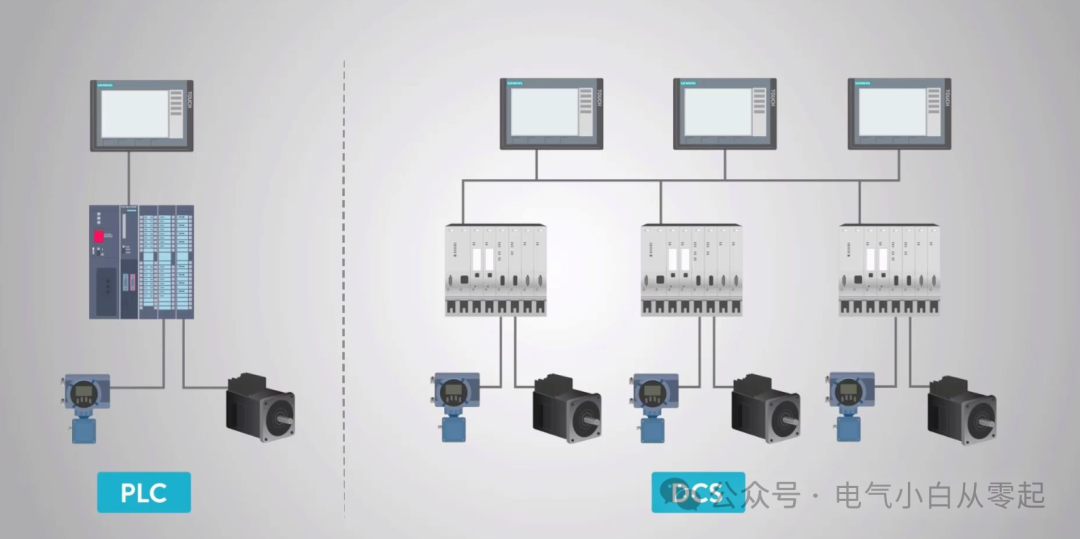In the field of industrial automation, DCS (Distributed Control System) and PLC (Programmable Logic Controller) are the two most common control systems. Although they overlap in certain functionalities, their design philosophies, architectures, and application scenarios differ significantly. This article will detail their differences and help you understand how to choose the appropriate control system.

1. Basic Concepts of DCS and PLC
(1) DCS (Distributed Control System)
DCS (Distributed Control System) is a decentralized control and centralized management system primarily used for large-scale, complex continuous process control, such as in the petrochemical, power, and pharmaceutical industries. The core feature of DCS is modular decentralized control, where each subsystem operates independently while exchanging data through high-speed networks to achieve centralized monitoring and optimization.
(2) PLC (Programmable Logic Controller)
PLC (Programmable Logic Controller) is an industrial computer designed specifically for logic control, mainly used for discrete manufacturing and sequential control, such as in automotive assembly lines, packaging machinery, and machine tool control. The characteristics of PLC include high reliability, fast response, and flexible programming, making it suitable for handling logical tasks such as switching, timing, and counting.
2. Core Differences Between DCS and PLC
| Comparison Item | DCS | PLC |
|---|---|---|
| Control Method | Decentralized control, centralized management | Centralized control, independent operation |
| Applicable Scenarios | Continuous process control (e.g., chemical, power) | Discrete manufacturing control (e.g., assembly, packaging) |
| System Scale | Large-scale, complex systems | Medium to small-scale, modular systems |
| Response Speed | Relatively slow (seconds) | Very fast (milliseconds) |
| Programming Method | Function Block Diagram (FBD), Sequential Function Chart (SFC) | Ladder Diagram (LD), Structured Text (ST) |
| Scalability | Strong, easy to expand | Dependent on modular expansion |
| Cost | Higher (overall system) | Lower (per unit cost) |
| Typical Vendors | Honeywell, Emerson, Yokogawa | Siemens, Rockwell, Mitsubishi |
3. Typical Application Scenarios
(1) Applicable Scenarios for DCS
DCS is suitable for industries that require high reliability and complex coordinated control, such as:
-
Petrochemical: Continuous process control in refining, ethylene production, etc.
-
Power Industry: Boiler and turbine control in thermal power plants and nuclear power stations
-
Pharmaceutical Industry: Temperature control and process management in fermentation and reaction vessels
-
Water Treatment: Automation control in large sewage treatment plants
In these scenarios, DCS’s distributed architecture ensures that a failure in one subsystem does not affect overall operation while providing advanced optimization algorithms (such as PID control and model predictive control).
(2) Applicable Scenarios for PLC
PLC is more suitable for high-speed, discrete logic control, such as:
-
Automotive Manufacturing: Sequential control in welding, painting, and assembly lines
-
Packaging Machinery: Control of actions such as filling, sealing, and labeling
-
Machine Tool Control: Motion control in CNC machining centers
-
Logistics Automation: Control of sorting systems and conveyor belts
The high response speed and flexible I/O configuration of PLC make it excel in scenarios requiring rapid logical decision-making.
4. How to Choose? DCS or PLC?
| Selection Factors | Recommended System |
|---|---|
| Large-scale continuous process control | DCS |
| High-speed discrete logic control | PLC |
| Need for advanced optimization algorithms | DCS |
| Low cost, simple control | PLC |
| High reliability, redundancy requirements | DCS |
| Modular, easy to expand | PLC |
In recent years, with the development of Industry 4.0, the boundaries between PLC and DCS have gradually blurred, for example:
-
PLC + SCADA: Achieving some DCS functions (such as data acquisition and monitoring) through SCADA systems
-
DCS Integrated with PLC: Some DCS vendors (such as Siemens PCS 7) have integrated the high-speed control capabilities of PLCs
Therefore, when making actual selections, it is necessary to consider factors such as process requirements, budget, and scalability comprehensively.
5. Conclusion
-
DCS: Suitable for large-scale, continuous process control, emphasizing system coordination and advanced optimization.
-
PLC: Suitable for high-speed, discrete logic control, emphasizing fast response and flexibility.
-
Future Trends: Integration of both, such as edge computing and Industrial Internet of Things (IIoT) driving the intelligence of control systems.
I hope this article helps you better understand the differences between DCS and PLC and make the best choice in your actual projects!
Follow us for more industrial automation insights! 🚀